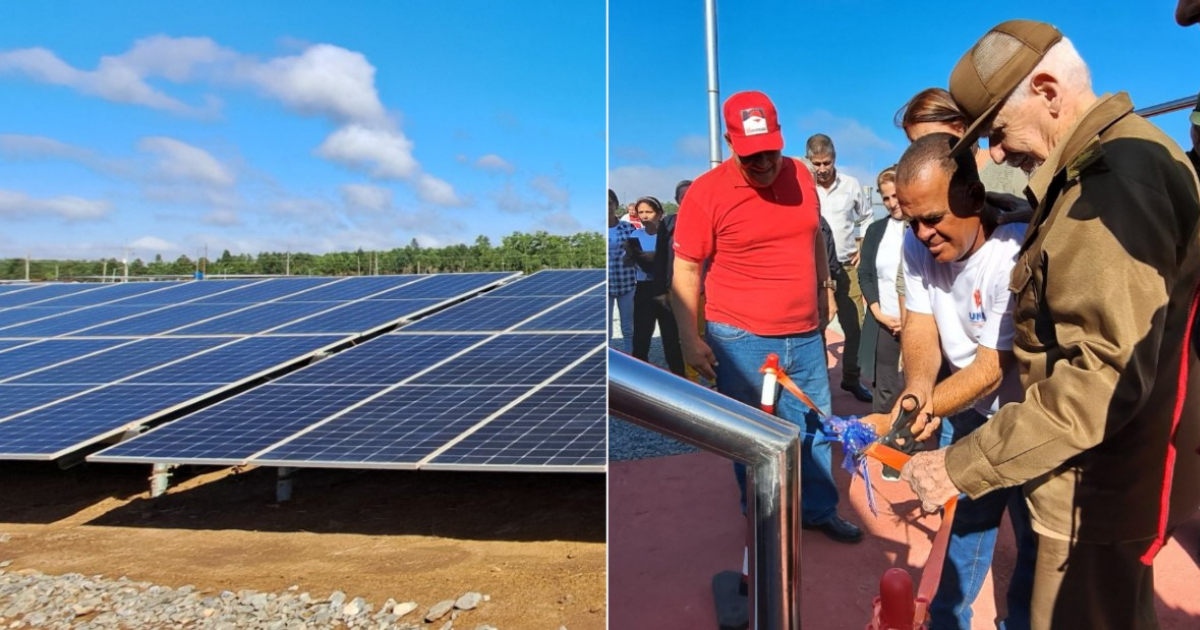
Related videos:
The Cuban regime inaugurated the photovoltaic solar park "Alcade Mayor" in the province of Cienfuegos this Saturday, as part of its strategy to promote renewable energies amid a severe energy crisis.
The installation, which contributes 21 megawatts (MW) to the National Electroenergetic System (SEN), was introduced as a step forward within the government plan to reduce dependence on fossil fuels.
At the inauguration ceremony, Commander Ramiro Valdés, a key figure in the country's energy decisions, was present, but this time without the attendance of the ruler Miguel Díaz-Canel.
The Minister of Energy and Mines, Vicente de la O Levy, celebrated the launch of the park and reaffirmed the government's commitment to renewable energy. "This is a macro program; it's made up of many small initiatives," the official stated on social media. According to official data, the park's operation will allow for a savings of 9,000 tons of fossil fuels per year.
An ambitious plan amid the crisis
The "Alcade Mayor" solar park joins the "Nursing School" in Havana, which was inaugurated weeks earlier, featuring 42,588 solar panels and a capacity of 21.8 MW. Both parks are part of the investment plan that aims to install 46 solar parks with a total generation of 1,200 MW before the end of 2025.
However, popular skepticism is high, given the history of unfulfilled promises and the ongoing deterioration of the country's energy infrastructure. The day before the inauguration of the solar park in Cienfuegos, the SEN reported generation deficits exceeding 1,500 MW, which forced rationing in several provinces.
The thermal power plant Antonio Guiteras, the largest in the country, is in critical condition, with corroded structures and constant failures that limit its generation capacity. Other plants, such as the thermal power plants in Nuevitas, Mariel, and Felton, are also out of service or under maintenance, worsening the collapse of the national electrical system (SEN).
China, a key player in Cuba's energy strategy
The Cuban government has relied on support from China in its efforts to promote renewable energy. Last November, during the International Fair of Havana, the company Hangzhou Duojia Technology Co. Ltd reaffirmed its commitment to the island's energy transition, stating that solar panels are the "definitive solution" to Cuba's electrical crisis.
According to its president, Qiaoming Huang, the company has supplied solar technology for small commercial projects, and containers of solar panels and lithium batteries have been sent to the island. In April 2024, the Cuban government and China signed an agreement to expand the use of solar energy in the Cuban power grid, although details have not been provided on how the megaproject will be financed.
Additionally, in November, the Ministry of Energy and Mines announced an even more ambitious plan: the installation of 2,000 MW of solar energy by 2028, with a first phase of 1,000 MW scheduled to begin operations in the summer of 2025.
A real solution or an inadequate palliative?
Despite the government's efforts to highlight these projects as a step towards energy independence, the population continues to suffer the effects of the collapse of the SEN. In recent days, blackouts have reached alarming levels, with reports of prolonged power outages and energy availability well below demand.
The "Alcade Mayor" solar park is another component of the government plan, but its actual impact on the energy crisis remains uncertain. Meanwhile, Cubans continue to live in the uncertainty of a crumbling electrical infrastructure and official promises that have not yet managed to put an end to the blackouts.
Frequently Asked Questions about the Energy Crisis in Cuba and Solar Parks
What does the inauguration of the "Alcade Mayor" solar park represent in the energy crisis in Cuba?
The "Alcade Mayor" solar park is part of the Cuban government's effort to diversify the country's energy matrix and reduce reliance on fossil fuels. However, its impact on the energy crisis remains uncertain, as electrical infrastructure continues to deteriorate and power outages are frequent.
How much will the "Alcade Mayor" solar park contribute to the National Electroenergetic System?
The "Alcade Mayor" solar park will contribute 21 megawatts (MW) to the National Electro-Energy System (SEN), enabling a savings of 9,000 tons of fossil fuels per year.
What challenges does Cuba face in its transition to renewable energy?
Cuba faces significant challenges such as lack of investment, infrastructure deterioration, and fuel shortages. Additionally, dependence on foreign technologies and economic issues complicate the effective implementation of renewable energy projects.
What role does China play in Cuba's energy strategy?
China is a key player in Cuba's energy strategy, providing technology and advice for the construction of solar parks. This collaboration aims to promote the energy transition on the island, although the viability of these projects remains in question.
Filed under: